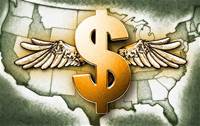US Falls Out of Top 10 For Economic Freedom
Thursday, February 13th, 2014 @ 10:58PM
Between the Lines
by Gary D. Halbert
World economic freedom has reached record levels according to the 2014 Index of Economic Freedom released in late January by the Heritage Foundation and The Wall Street Journal. But after seven straight years of decline, the US has dropped out of the top 10 most economically free countries.
For 20 years, the Index has measured many nations’ commitment to free enterprise on a scale of 0 to 100 by evaluating 10 categories, including fiscal soundness, government size, property rights, etc. These commitments have powerful effects: Countries achieving higher levels of economic freedom consistently and measurably outperform others in economic growth, long-term prosperity and social progress.
Those losing freedom, on the other hand, risk economic stagnation, high unemployment and deteriorating social conditions. For instance, heavy-handed government intervention in Brazil’s economy continues to limit mobility and fuels a growing sense of injustice.
As you can see in the chart below, the United States has fallen to #12 in the ranking, the lowest ever:
It’s not hard to see why the US is losing ground. Even marginal tax rates exceeding 43% (39.6% + 3.8% = 43.4%) cannot finance runaway government spending, which has caused the national debt to skyrocket. The Obama administration continues to shackle entire sectors of the economy with regulation, including healthcare, finance and energy just to name a few. This intervention impedes both personal freedom and national prosperity.
But as the US economy languishes, many countries are leaping ahead, thanks to policies that enhance economic freedom – the same ones that made the US economy the most powerful in the world in years past. Governments in 114 countries have taken steps in the past year to increase the economic freedom of their citizens. Forty-three countries, from every part of the world, have now reached their highest economic freedom ranking in the Index’s history.
Hong Kong continues to dominate the list, followed by Singapore, Australia, Switzerland, New Zealand and Canada. These are the only countries to earn the index’s “economically free” designation. Despite the turmoil in the Middle East, several Gulf States, led by Bahrain, earned the designation of “mostly free.”
A realignment is underway in Europe, according to the Index’s findings. Eighteen European nations, including Germany, Sweden, Georgia and Poland, have reached new highs in economic freedom. By contrast, five others – Greece, Italy, France, Cyprus and the United Kingdom – registered scores lower than they received when the Index started two decades ago.
The US and the UK, historically champions of free enterprise, have suffered the most pronounced declines. Both countries now fall in the “mostly free” category. Some of the worst performers are in Latin America, particularly Venezuela, Argentina, Ecuador and Bolivia.
Despite financial crises and recessions, the global economy has expanded by nearly 70% in 20 years, to $54 trillion in 2012, up from $32 trillion in 1993. Hundreds of millions of people have left grinding poverty behind as their economies have become freer. But it is an appalling, avoidable human tragedy how many of the world’s peoples remain unfree and poor.
The record of increasing economic freedom elsewhere makes it inexcusable that a country like the US continues to pursue policies that are detrimental to its own growth, while wielding its influence to encourage other countries to chart the same disastrous course.
The 2014 Index of Economic Freedom documents a worldwide race to enhance economic opportunity through greater freedom – and this year’s Index demonstrates that the US needs a drastic change in direction.
Unfortunately, President Obama’s policies of higher taxes, onerous regulations and the takeover of 17% of the economy (healthcare) means that the US is likely to continue on its current downward path.
Posted by AIA Research & Editorial Staff
Categories: Between the Lines



